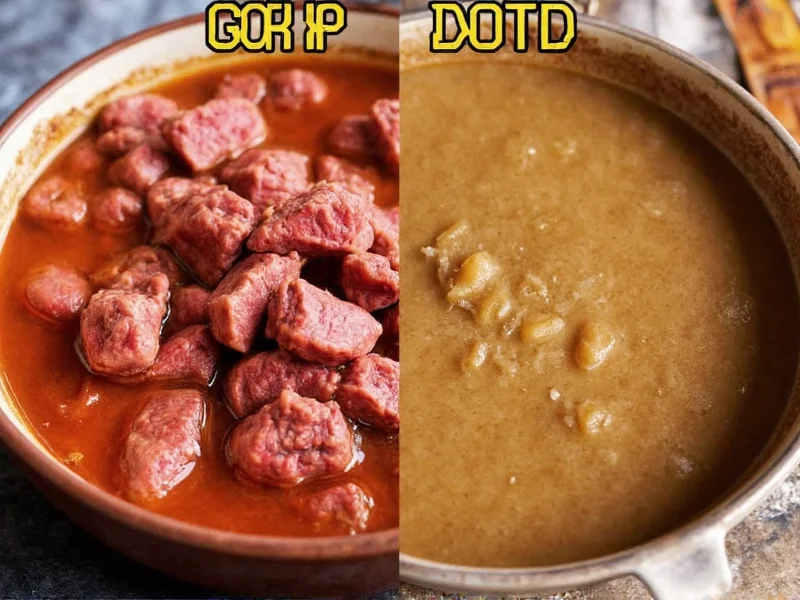Many home cooks and even professional chefs use the terms "beef stock" and "beef broth" interchangeably, but culinary professionals recognize important technical differences that affect both flavor development and texture in finished dishes. These distinctions matter significantly when preparing sauces that require reduction, soups needing body, or dishes where gelatin content impacts mouthfeel.
What Exactly Is Beef Stock?
Beef stock represents the culinary foundation of many classic French and European preparations. It begins with beef bones—typically marrow bones, knuckle bones, or oxtail—that undergo roasting to develop complex flavors through the Maillard reaction. The roasted bones simmer for an extended period, usually 8-12 hours, sometimes up to 24 hours for professional applications.
This prolonged cooking extracts collagen from the bones and connective tissues, which converts to gelatin. When properly made and cooled, quality beef stock will solidify into a jelly-like consistency—a clear indicator of sufficient collagen extraction. Stock contains minimal seasoning, as its primary purpose is to provide body and subtle background flavor rather than immediate taste.
Defining Beef Broth: Flavor First
Beef broth prioritizes immediate flavor over structural properties. It typically uses more meat than bones—often chuck, shank, or other meaty cuts—with bones included primarily for flavor rather than collagen extraction. The simmering time is significantly shorter, usually 2-4 hours, as overcooking meat would make it tough and stringy.
Broth receives seasoning during preparation, making it palatable to drink on its own. Commercial broths often contain additional flavor enhancers, salt, and seasonings to create a more pronounced taste profile. The resulting liquid has less body than stock and won't gel when cooled due to lower collagen content.
Key Differences at a Glance
| Characteristic | Beef Stock | Beef Broth |
|---|---|---|
| Primary Ingredients | Bones (70-80%),少量 meat, mirepoix | Meat (60-70%), some bones, mirepoix |
| Simmering Time | 6-12+ hours | 2-4 hours |
| Gelatin Content | High (gels when cooled) | Low (remains liquid) |
| Seasoning | Minimal (just enough for balance) | Significant (palatable on its own) |
| Culinary Purpose | Building block for sauces and soups | Consumed directly or in finished dishes |
| Flavor Profile | Subtle, nuanced, background notes | Pronounced, immediate, forward taste |
| Color | Deeper brown (from roasted bones) | Lighter brown (often unroasted bones) |
When to Use Each: Practical Kitchen Guidance
Understanding when to reach for stock versus broth separates competent cooks from exceptional ones. For sauces that require reduction—like demi-glace or pan sauces—beef stock provides the necessary gelatin to create a luxurious mouthfeel and proper consistency without requiring additional thickeners. The collagen in stock also helps emulsify fats, creating stable, glossy sauces.
Beef broth shines when you need immediate flavor without further development. It works well for soups meant to be consumed as-is, for cooking grains like rice or quinoa, or when deglazing pans for quick pan sauces. Many professional chefs actually build layers of flavor by starting with stock as a base, then finishing with broth for additional flavor complexity.
Substitution Considerations
While you can substitute beef broth for stock in many recipes, the results will differ. Using broth in place of stock may yield sauces that lack body and don't coat the back of a spoon properly. Conversely, using stock instead of broth might result in underseasoned dishes since stock contains less salt and immediate flavor.
If substituting stock for broth, plan to add additional seasoning and possibly some cooked meat for flavor. When replacing stock with broth, consider adding unflavored gelatin (1/2 teaspoon per cup) to compensate for the lower collagen content, especially in sauces and braises where texture matters.
Homemade Preparation Tips
For superior beef stock, roast bones at 400°F (200°C) for 45-60 minutes until deeply browned. Add mirepoix (onion, carrot, celery), tomato paste, and aromatics before covering with cold water. Simmer uncovered for 8-12 hours, skimming impurities regularly. Strain through cheesecloth for crystal-clear results.
For beef broth, combine meaty bones and meat trimmings with mirepoix in cold water. Bring to a gentle simmer (never a rolling boil) and cook for 3-4 hours. Add salt and herbs during the last hour. The shorter cooking time preserves the meat's integrity while extracting flavor.
Navigating Store-Bought Options
Reading labels carefully reveals significant differences among commercial products. Many "stocks" are actually broths with added gelatin to mimic stock's properties. Look for products labeled "bone broth" which typically have longer simmering times and higher collagen content. Low-sodium versions give you better control over seasoning in your final dish.
When evaluating store-bought options for the difference between beef stock and beef broth for cooking applications, check the ingredient list for gelatin content and seasoning levels. Professional-grade brands like Fond de Veau Gold Label or Rich Demarco offer true stock formulations, while standard grocery store broths often contain MSG and excessive sodium.
Common Misconceptions Clarified
One widespread misconception claims that stock contains more flavor than broth, when in reality broth typically has more immediate, pronounced flavor while stock provides structural benefits. Another myth suggests that stock must always be made from bones alone—most professional recipes include some meat for flavor development.
The confusion between beef stock vs beef broth often stems from inconsistent labeling practices in the food industry. Many manufacturers use the terms interchangeably for marketing purposes, further muddying the waters for home cooks seeking authentic culinary results.











 浙公网安备
33010002000092号
浙公网安备
33010002000092号 浙B2-20120091-4
浙B2-20120091-4